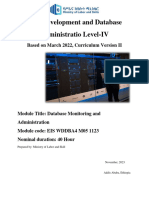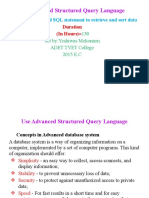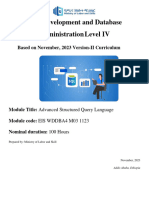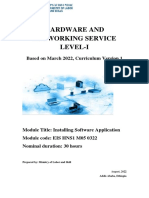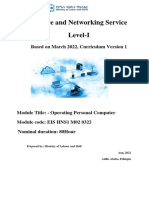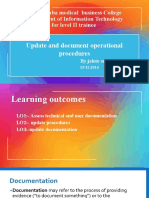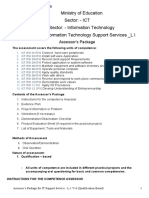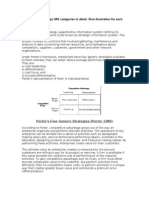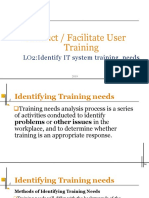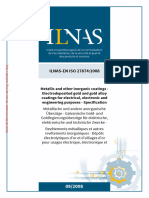TM09 Monitoring and Supporting Data Conversion
Uploaded by
borenadinagde1TM09 Monitoring and Supporting Data Conversion
Uploaded by
borenadinagde1RV TVET College 2024
Web Development and Database
Administration
Level III
Based on November, 2023 Version-II Occupational
Standard (OS)
Module Title: Monitoring and Supporting Data
Conversion
Module code: EIS WDDBA3 M09 0323
Nominal duration: 30 Hours
Prepared by: Borena D. (BSc)
October, 2024 Nekemte, Oromia
RV TVET College 2024
Table of Contents
Acknowledgment.............................................................................................................................1
Acronym..........................................................................................................................................2
Introduction to the Module..............................................................................................................3
Unit One: Monitor Data Conversion..............................................................................................4
1.1. Current data model methodologies.......................................................................................5
1.2. Conversion support documentation......................................................................................7
1.3. Back up data before conversion............................................................................................9
1.4. Identification Client requirements......................................................................................10
1.5. Software, hardware or environmental pre-requisites..........................................................10
1.6. Data Conversion Tools.......................................................................................................11
1.7. Validation data accuracy and integrity...............................................................................11
1.8. Documentation of data rejection behavior of the conversion.............................................13
Self- check 1..................................................................................................................................15
Unit Two: SUPPORT DATA CONVERSION............................................................................16
2.1. Verification of data.............................................................................................................17
2.2. Store, update and export convert data.................................................................................18
2.3. Data loading and indexing on the production server..........................................................19
2.4. Documentation of backup copies of conversion files.........................................................20
Self check2.....................................................................................................................................22
Operation sheet 2.1 monitoring and Supporting Data...................................................................23
Lap Tests........................................................................................................................................27
Reference.......................................................................................................................................28
Developer’s Profile........................................................................................................................29
Prepared By Borena D. (BSc, Computer Science) Page 1
RV TVET College 2024
Acknowledgment
Borena D. (BSc)s wish to extend thanks and appreciation to the many representatives of TVT
instructors and respective industry experts who donated their time and expertise to the
development of this Teaching, Training and Learning Materials (TTLM).
Prepared By Borena D. (BSc, Computer Science) Page 1
Acronym
GIF--------------------------------------------------------------------- Graphics Interchange Format
JPG----------------------------------------------------------------------Joint Photographic Experts Group
MS Access---------------------------------------------------------------Microsoft Access
PDF----------------------------------------------------------------------Portable Document Format
PNG----------------------------------------------------------------------Portable Network Graphic
SQL----------------------------------------------------------------------Structured Query Language.
TIFF-----------------------------------------------------------------------Tag Image File Format
XLS-------------------------------------------------------------------------Microsoft Excel spreadsheet.
XML-------------------------------------------------------------------------Extensible Markup Language
Prepared By Borena D. (BSc, Computer Science) Page 2
Introduction to the Module
This module provides as the process of translating data from one format to another. It involves
the planning of steps and mapping of data fields to convert one set/type of data into a different,
more desired, format. .The goal of data conversion is to prevent data loss or corruption by
maintaining the integrity of the data and embedded structures.
This module covers the units:
Monitor data conversion
Support data conversion
Module Instruction
For effective use this modules trainees are expected to follow the following module instruction:
1. Read the information written in each unit
2. Accomplish the Self-checks at the end of each unit
3. Perform Operation Sheets which were provided at the end of units
4. Do the “LAP test” giver at the end of each unit and
5. Read the identified reference book for Examples and exercise
Prepared By Borena D. (BSc, Computer Science) Page 3
Unit One: Monitor Data Conversion
This unit is developed to provide you the necessary information regarding the following content
coverage and topics
Current data model methodologies.
Conversion support documentation.
Back up data before conversion.
Identification Client requirement.
Software, hardware or environmental pre-requisites
Validation data accuracy and integrity.
Data conversion tools.
Documentation of data rejection behavior of the conversion.
This unit will also assist you to attain the learning outcomes stated in the cover page.
Specifically, upon completion of this learning guide, you will be able to:
Identify data model methodologies
Apply Convert support document.
Protect data before conversion.
Understand Client requirements.
Identify Software, hardware or environmental pre-requisites.
Validate data accuracy and integrity
Understand data conversion tools
documents data rejection behavior of the conversion
Prepared By Borena D. (BSc, Computer Science) Page 4
1.1. Current data model methodologies
Defining concepts of data conversion and Data Terminologies
Data is raw facts or unorganized things (such as alphabets, numbers, or symbols) that
refers to, or represent, conditions, ideas, or objects.
It can be qualitative or quantitative.
Qualitative data is descriptive information (it describes something)
Quantitative data is numerical information (numbers).
Discrete data can only take certain values (like whole numbers)
Continuous data can take any value (within a range)
Put simply: Discrete data can be counted, Continuous data can be measured
Qualitative:
It is brown and black
It has long hair
It has lots of energy
Quantitative:
Discrete:
o It has 4 legs
o It has 10 fingers
Continuous:
o It weighs 25.5 kg
o It is 565 mm tall
Data conversion is the conversion of one file or database from one format (from one
physical environment) to another.
Types of conversion:
Complied By Borena D. (Computer Science BSc) Page 5
Database conversion (SQL, MySQL, MS Access, XLS, XML etc)
File format conversion (PDF to Word)
Image conversion (GIF to JPG, TIFF, PNG etc)
Character or string conversion(numeric to alphabet or vice versa)
Understanding Data and Its Characteristics
Data Conversion Systems and Tools Data Conversion Tool allow you to convert data both from
and to (both sides are supported) a wide variety of formats, including:
SQL Server Tables
Oracle Tables
ODBC Tables
OleDb Tables
Microsoft Access Tables
XML Files
Data Modeling Methodologies
Data modeling is the formalization and documentation of existing processes and events that
occur during application software design and development.
Data modeling techniques and tools capture and translate complex system designs into easily
understood representations of the data flows and processes, creating a blueprint for construction
or re-engineering.
A data model can be thought of as a diagram or flowchart that illustrates the relationships
between data.
There are several different approaches of data modeling, including:
Conceptual Data Modeling: identifies the highest-level relationships between different
entities.
Logical Data Modeling: illustrates the specific entities, attributes and relationships
involved in a business function.
Physical Data Modeling: represents an application and database-specific implementation
of a logical data model.
Complied By Borena D. (Computer Science BSc) Page 6
Data Conditioning and cleaning
Data cleaning is the process of fixing or removing incorrect, corrupted, incorrectly formatted,
duplicate, or incomplete data within a dataset. When combining multiple data sources, there are
many opportunities for data to be duplicated or mislabeled. If data is incorrect, outcomes and
algorithms are unreliable, even though they may look correct. There is no one absolute way to
prescribe the exact steps in the data cleaning process because the processes will vary from
dataset to dataset. But it is crucial to establish a template for your data cleaning process so you
know you are doing it the right way every time.
Data conditioning (Pre-processing) is the use of data management and optimization techniques
which result in the intelligent routing, optimization and protection of data for storage or data
movement in a computer system.
Data cleaning is the act of detecting and removing or correcting dirty data (i.e.: data that is
incorrect, out-of-date, redundant, incomplete, or formatted incorrectly).
Data Cleaning helps to increase the overall efficiency of your data management systems and
leads to an increase in the productivity of the organization.
Data Transformation and integration
Data transformation is one of the collective processes known as extract, transform or load which
is one of the most important processes in data warehouse implementation from different data
sources.
Data Integration is the process of combining heterogeneous data sources in to a single queriable
schema so as to get a unified view of these data.
1.2. Conversion support documentation
Obtaining and applying conversion supporting documentation is an important part of the data
conversion process. This documentation typically includes a detailed description of the data
being converted, the format and structure of the data, and any rules or standards that must be
followed during the conversion process.
To obtain this documentation, you should reach out to the owners or custodians of the data and
request the appropriate documentation. Once you have the documentation, you should review it
Complied By Borena D. (Computer Science BSc) Page 7
thoroughly and ensure that you understand all the requirements and guidelines for the conversion
process.
During the conversion process, you should refer to the documentation frequently to make sure
that you are following all the guidelines and rules. If you encounter any issues or questions
during the conversion process, you should reach back out to the owners or custodians of the data
for clarification.
By obtaining and applying conversion supporting documentation, you can ensure that the data
conversion process is accurate, complete, and compliant with all the necessary requirements and
standards.
Monitoring the data conversion process is an important aspect of ensuring a successful project
outcome. To monitor data conversion, you should consider the following:
Define monitoring criteria: define the criteria that will be used to monitor the data
conversion process. This may include data accuracy, completeness, consistency, and
integrity.
Establish monitoring processes: Establish processes for monitoring the data conversion
process. This may include using automated tools, manual review, or a combination of
both.
Monitor the conversion process: monitor the data conversion process regularly to ensure
that it is running smoothly and that all requirements and specifications are being met.
Identify issues: Identify any issues or challenges that arise during the conversion process
and develop a plan to address them.
Communicate with stakeholders: Communicate regularly with stakeholders to provide
updates on the progress of the data conversion process and to address any concerns or
issues that arise.
Complied By Borena D. (Computer Science BSc) Page 8
Conduct testing: Conduct testing to ensure that the converted data is accurate and
complete and that it meets the necessary requirements and specifications.
By monitoring the data conversion process, you can identify any issues or challenges early on
and take corrective action to address them. This will help to ensure that the end result meets the
necessary requirements and specifications and that the project is successful
Reading and Analyzing Existing Data Conversion Documents
The data conversion process can often be a complex and difficult task during an implementation.
When performing data conversions, you must include analysis of your source data and continues
through to system testing and user acceptance.
Throughout the conversion process, we perform quality control checks to ensure correctness of
the conversion.
1.3. Back up data before conversion.
Protecting production data is a critical aspect of the data conversion process. One way to protect
production data is to ensure that you have a backup of all the data before starting the conversion
process. This backup should be kept in a secure location and should be easily accessible in case
of any issues or errors during the conversion process.
To ensure that you have a backup of the production data, you should create a backup schedule
that takes regular backups of the data. This schedule should be based on the frequency of data
updates and the criticality of the data. For example, if the data is updated frequently and is
critical to the business, you may want to take backups every few hours or daily.
In addition to taking backups, you should also test the backup process to ensure that the backups
are complete and accurate. This testing should be done regularly to ensure that the backup
process is working properly.
By taking action to ensure backups before conversion, you can protect production data and
ensure that you have a reliable fallback in case of any issues or errors during the conversion
process.
1.4. Identification Client requirements.
Determining and impacting the requirements of the client on business operations is a critical
aspect of any project. To do this effectively, you should first understand the client's requirements
Complied By Borena D. (Computer Science BSc) Page 9
and how they impact the business operations. This involves engaging with the client and asking
questions to understand their needs and expectations.
Once you have a clear understanding of the client's requirements, you should evaluate how they
impact the business operations. This involves assessing the current business processes and
identifying any changes or modifications that may be required to meet the client's needs.
You should then develop a plan to implement the changes or modifications. This plan should
include timelines, resource requirements, and any potential risks or issues that may arise during
the implementation process.
Throughout the implementation process, you should communicate regularly with the client to
ensure that their requirements are being met and that any issues or concerns are addressed in a
timely manner. You should also monitor the impact of the changes on the business operations
and make any necessary adjustments to ensure that the business continues to run smoothly.
By determining and impacting the requirements of the client on business operations, you can
ensure that the project is successful and that the client's needs are met while minimizing any
disruption to the business operations
1.5. Software, hardware or environmental pre-requisites
Identifying and confirming software, hardware, or environmental pre-requisites is an important
part of the conversion planning process. To do this, you should review the conversion plan and
identify any software, hardware, or environmental requirements that are necessary for the
conversion process.
Once you have identified these requirements, you should confirm that they are available and
meet the necessary specifications. This may involve testing the hardware and software to ensure
that they are compatible with the conversion process and that they meet the necessary
performance requirements.
If any gaps or issues are identified during this process, you should develop a plan to address
them. This may involve upgrading hardware or software, adjusting the conversion plan to
accommodate the limitations, or finding alternative solutions that meet the requirements.
It's important to confirm these pre-requisites before starting the conversion process to avoid any
delays or issues during the conversion process. By identifying and confirming these pre-
Complied By Borena D. (Computer Science BSc) Page 10
requisites early on, you can ensure that the conversion process runs smoothly and that the end
result meets the necessary requirements and specifications.
1.6. Data Conversion Tools
o Software
o Hardware
o Environmental Pre-Requisites (Dust, Heat, Extreme Cold, Temperature Stability, Air
Circulation and Moisture)
Dust and Dirty environment increases the overheating problem and mostly affects
o The Motherboard.
o The Processor and Power Supply fan.
o The CD-drive's Lens and Floppy drive's head.
o The Add-in card connection.
o The cable connection.
o The mouse and keyboard.
1.7. Validation data accuracy and integrity
Validating data accuracy and integrity is a critical part of the data conversion process. To do this,
you should develop a validation plan that includes the following steps:
Define the validation criteria: Define the criteria that will be used to validate the data.
This may include data accuracy, completeness, consistency, and integrity.
Develop the validation process: Develop a process for validating the data. This may
include using automated tools, manual review, or a combination of both.
Validate the data: Execute the validation process and review the results. Identify any
discrepancies or errors and make the necessary corrections.
Re-validate the data: After making corrections, re-validate the data to ensure that all
errors have been addressed.
Document the validation results: Document the results of the validation process,
including any errors or discrepancies that were identified and how they were addressed.
Obtain sign-off: Obtain sign-off from the appropriate stakeholders, including the client,
to confirm that the data is accurate and meets the conversion specifications.
Complied By Borena D. (Computer Science BSc) Page 11
By following this validation plan, you can ensure that the data is accurate and meets the
necessary specifications before it is used in the production environment. This will help to
minimize any errors or issues that may arise during the production phase of the project.
Validating data accuracy and integrity according to conversion specifications.
Validating data accuracy and integrity is a critical part of the data conversion process. To
do this, you should develop a validation plan that includes the following steps:
Define the validation criteria: Define the criteria that will be used to validate the data.
This may include data accuracy, completeness, consistency, and integrity.
Develop the validation process: Develop a process for validating the data. This may
include using automated tools, manual review, or a combination of both.
Validate the data: Execute the validation process and review the results. Identify any
discrepancies or errors and make the necessary corrections.
Re-validate the data: After making corrections, re-validate the data to ensure that all
errors have been addressed.
Document the validation results: Document the results of the validation process,
including any errors or discrepancies that were identified and how they were addressed.
Obtain sign-off: Obtain sign-off from the appropriate stakeholders, including the client,
to confirm that the data is accurate and meets the conversion specifications.
By following this validation plan, you can ensure that the data is accurate and meets the
necessary specifications before it is used in the production environment. This will help to
minimize any errors or issues that may arise during the production phase of the project.
Identify the cause of the rejection: Identify the reason why the data was rejected by the
conversion tool. This may involve reviewing the error logs or working with the
development team to troubleshoot the issue.
Determine if the data can be corrected: Determine if the rejected data can be corrected or
if it needs to be excluded from the conversion process.
Develop a plan for correcting the data: If the data can be corrected, develop a plan for
how to correct it. This may involve manual correction or the use of automated tools.
Exclude the data from the conversion process: If the data cannot be corrected, exclude it
from the conversion process and develop a plan for how to address any impacts this may
have on the business operations.
Complied By Borena D. (Computer Science BSc) Page 12
Document the rejected data: Document the rejected data, including the reason for the
rejection and any actions taken to correct it or exclude it from the conversion process.
By developing a plan for handling rejected data, you can minimize the impact on the conversion
process and ensure that the end result meets the necessary specifications and requirements.
1.8. Documentation of data rejection behavior of the conversion.
Documenting data rejection or errant behavior of the conversion process is an important part of
the data conversion process. To do this, you should develop a documentation plan that includes
the following steps:
Define the documentation requirements: Define the types of data rejection or errant
behavior that need to be documented. This may include data that is rejected by the
conversion tool, data that is corrupted during the conversion process, or any other
issues that arise during the process.
Develop the documentation process: Develop a process for documenting the data
rejection or errant behavior. This may include using a tracking system, logging errors,
or using a spreadsheet to track the issues.
Document the data rejection or errant behavior: Document the data rejection or
errant behavior as it occurs. Include details such as the date and time of the issue, the
type of data that was rejected or corrupted, and any error messages that were
generated.
Assign responsibility: Assign responsibility for documenting and addressing the data
rejection or errant behavior. This may include the project manager, the development
team, or other stakeholders.
Develop a plan for addressing the issues: Develop a plan for how to address the data
rejection or errant behavior. This may involve manual correction, the use of
automated tools, or other actions.
Review and update the documentation: Review and update the documentation
regularly to ensure that it is accurate and up-to-date.
By documenting data rejection or errant behavior, you can identify trends and patterns in the
conversion process and take corrective action to address the issues. This will help to ensure that
the end result meets the necessary specifications and requirements.
Complied By Borena D. (Computer Science BSc) Page 13
Self- check 1
Part I. Choose the best answer
1. Which of the following is not qualitative data type?
A. It is brown and black
B. It has long hair
C. t has 4 legs
D. All
2. Which of the following is not quantitative data type?
A. It has 4 legs
B. t has long hair
C. Revenue in dollars.
D. Age in months or years.
3. Which of the following is not monitor data conversion process?
A. Define monitoring criteria
B. Establish monitoring processes
C. Validate the data
D. All.
4. Which of the following is used to develop validation plan?
A. Define the validation criteria
B. Develop the validation process
C. Validate the data
D. All.
Part III. Short Answer Questions
1. What is data?
2. What is Data conversion?
3. Write down at least five advantage of Data Conversion?
4. What is information?
5. What is back up data?
Complied By Borena D. (Computer Science BSc) Page 14
Unit Two: SUPPORT DATA CONVERSION
This unit is developed to provide you the necessary information regarding the following content
coverage and topics
Verification of data
Store, update and export convert data
Data loading and indexing on the production server
Documentation of backup copies of conversion files
This unit will also assist you to attain the learning outcomes stated in the cover page.
Specifically, upon completion of this learning guide, you will be able to:
Understand and verify data.
Store, update and export converted data
identify data load and indexing on the production server
Document backup copies of conversion files
Complied By Borena D. (Computer Science BSc) Page 15
2.1. Verification of data
Verifying results based on a relevant checklist is an important part of the data conversion
process. To do this, you should develop a checklist that includes all the relevant requirements,
specifications, and standards that must be met during the conversion process.
Once you have developed the checklist, you should use it to verify the results of the conversion
process. This may involve reviewing the data, comparing it to the original data, and checking for
any errors or discrepancies.
If any issues or discrepancies are identified during the verification process, you should document
them and develop a plan to address them. This may involve making corrections to the data,
adjusting the conversion process, or finding alternative solutions that meet the requirements.
It's important to document the results of the verification process, including any issues or
discrepancies that were identified and how they were addressed. This documentation can be used
to track the progress of the conversion process and to ensure that all requirements and
specifications have been met.
By verifying results based on a relevant checklist, you can ensure that the conversion process is
accurate, complete, and compliant with all the necessary requirements and standards.
Present verify data and signing by appropriate person
Presenting the results of the data conversion process to the appropriate person and obtaining
sign-off is an important step in the project. To do this, you should develop a presentation that
includes all the relevant information about the conversion process, including the goals, timeline,
challenges, and results.
Once you have developed the presentation, you should schedule a meeting with the appropriate
person or group to present the results. During the presentation, you should highlight the key
findings and outcomes of the conversion process, including any issues that were encountered and
how they were addressed.
After the presentation, you should obtain sign-off from the appropriate person or group. This
sign-off confirms that the results of the conversion process meet the necessary requirements and
specifications, and that the project is complete.
It's important to document the sign-off, including the date, time, and names of the individuals
who provided it. This documentation can be used to track the progress of the project and to
ensure that all necessary approvals have been obtained.
Complied By Borena D. (Computer Science BSc) Page 16
By presenting the results of the data conversion process to the appropriate person and obtaining
sign-off, you can ensure that the project is complete and that all requirements and specifications
have been met.
2.2. Store, update and export convert data
Sorting data
Sorting data is the process of arranging items into meaningful order so that you can analyze it
more effectively.
Example:
sort text data into alphabetical order
sort numeric data into numerical order
Updating Data
The modification of data that is already in the database is referred to as updating. The update
operation allows you to change an existing database record in a logical or physical file. You can
update individual rows, all the rows in a table. Each column can be updated separately without
affecting other columns.
UPDATE table name
SET column1=value, column2=value2...
WHERE some_column=some_value
To perform an update, you need three pieces of information:
A. The name of the table and column to update,
B. The new value of the column,
C. Which row(s) to update?
Exporting data
You can export data from one application to another application using the Export
Wizard.
Exporting lets you share data from one application by providing a copy of data.
Ensuring Data Quality
DBMS provides a set of features that enable you to ensure the quality of data that is moved from
source systems to your data destination. Data profiling is a feature that enables you to analyze
Complied By Borena D. (Computer Science BSc) Page 17
the content and structure of your data to determine inconsistencies, anomalies, and redundancies
in the data.
Collection, Organization and Analysis of Data and Information
The data is typically organized to model relevant aspects of reality (for example, the availability
of rooms in hotels), in a way that supports processes requiring the information (for example,
finding a hotel with vacancies).
Organization of data
Organization of data is any one of the data management conventions for physical and spatial
arrangement of the physical records of a data set.
Analysis of data
Analysis of data is the process of evaluating data using analytical and logical reasoning to
examine each component of the data provided. Data from various sources is gathered, reviewed,
and then analyzed to form some sort of finding or conclusion.
Information
Information is processed data that can affect behavior, a decision or outcome.
It is valuable that is:-
accurate and timely
specific and organized for a purpose
presented within a context that gives it meaning and relevance
Can lead to an increase in understanding and decrease in uncertainty
2.3. Data loading and indexing on the production server
Data loading is the process of copying and loading data or data sets from a source file, folder or
application to a database or similar application. It is usually implemented by copying digital data
from a source and pasting or loading the data to data storage or processing utility.
Index Server Catalogs Index Server lets you use catalogs to conduct searches both on local
directories and on directories on other machines. A catalog contains the index of the contents of
the directories in its scope (i.e., a collection of directories that is indexed and searched as a unit).
In other words, a catalog is the highest level of organization in Index Server—it contains the
index for one or more scopes, which are simply references to subdirectories that you want to
include in the catalog.
Complied By Borena D. (Computer Science BSc) Page 18
2.4. Documentation of backup copies of conversion files
Maintaining and documenting backup copies of conversion files is an important part of the data
conversion process. To do this, you should develop a backup plan that includes the following
steps:
Determine the backup schedule: Determine how often backups will be taken and how
long they will be retained. This may depend on the frequency of data updates and the
criticality of the data.
Identify backup storage locations: Identify the locations where backup copies of the
conversion files will be stored. This may include cloud-based storage, local servers, or
external hard drives.
Develop a backup process: Develop a process for taking backups of the conversion files.
This may involve using automated tools or manual processes.
Test the backup process: Test the backup process to ensure that it is working properly and
that the backup copies of the conversion files are accurate and complete.
Document the backup process: Document the backup process, including the backup
schedule, storage locations, and backup process itself.
Maintain and update backup copies: Maintain and update the backup copies of the
conversion files regularly to ensure that they are up-to-date and accurate.
By maintaining and documenting backup copies of conversion files, you can ensure that you
have a reliable fallback in case of any issues or errors during the conversion process. This will
help to minimize any disruption to the business operations and ensure that the end result meets
the necessary requirements and specifications.
Develop clear and coherent technical documentation
Developing clear and coherent technical documentation is an important part of the data
conversion process. To do this, you should follow these best practices:
Define the audience: Define the target audience for the technical documentation. This
may include developers, testers, project managers, or other stakeholders.
Use clear and concise language: Use clear and concise language that is easy to
understand. Avoid technical jargon or acronyms that may not be familiar to the audience.
Use visual aids: Use visual aids such as diagrams, flowcharts, or screenshots to help
explain complex concepts or processes.
Complied By Borena D. (Computer Science BSc) Page 19
Organize the documentation: Organize the documentation in a logical and consistent
manner. Use headings, subheadings, and bullet points to break up the content and make it
easier to read.
Include examples: Include examples to illustrate how to perform specific tasks or use
specific features.
Update the documentation: Update the documentation regularly to ensure that it is up-to-
date and accurate.
Self check2
Part I: True False Questions
1. ________________Data loading is the process of copying and loading data or data sets
from a source file, folder or application to a database or similar application?
2. _________________ Analysis of data is any one of the data management conventions for
physical and spatial arrangement of the physical records of a data set.
Complied By Borena D. (Computer Science BSc) Page 20
3. ________________ Update operation allows you to change an existing database record
in a logical or physical file.
Part II. Short Answer Questions
1. What is the advantage of Verification of data?
2. What is sorting data?
3. What is Data loading?
4. What is data Analysis?
5. What is the Organization of data?
Operation sheet 2.1 monitoring and Supporting Data
Operation Title: PDF to word converter using Microsoft word 2019
Purpose: to allows for easy editing and manipulation of the content
Conditions or situations for the operations:
Safe working area
Properly operated tools and equipment
Complied By Borena D. (Computer Science BSc) Page 21
Equipment Tools and Materials:
Microsoft word 2019
Hardware
Software
Steps in doing the task
1. Right-click the PDF you want to open. If you're using a Mac and don't have a right
mouse button, press Control as you click the file. This will open a context menu.
Complied By Borena D. (Computer Science BSc) Page 22
2. Select Open with. It's near the top of the menu. Another menu will expand.
3 Click Word or Microsoft Word on the menu. This opens Word and attempts to display
the PDF
Complied By Borena D. (Computer Science BSc) Page 23
4 Click OK to convert the file. Word will convert the file to its own format and display the
results. If you're converting a larger file, it can take a few minutes to complete.
Edit the Word document. The converted document may not have perfect page to page
correspondence due to line and page breaks, graphics, and other details. Making manual
adjustments may be necessary.
4. Edit the Word document. The converted document may not have perfect page to page
correspondence due to line and page breaks, graphics, and other details. Making manual
adjustments may be necessary.
Complied By Borena D. (Computer Science BSc) Page 24
5. Save the converted PDF. Once you're ready to save the converted file as its own Word
document, do the following:
Windows — Click File, click Save As, click This PC, enter a file name, select a save
location on the left side of the window, and click Save.
Mac — Click File, click Save As, enter a name, select a file location, and click Save.
Lap Tests
Complied By Borena D. (Computer Science BSc) Page 25
Instructions: Given necessary templates, tools and materials you are required to perform the
following tasks accordingly.
Task 1: Monitor the conversion process
Task2: Identify challenges that arise during the conversion process
Task3: Conduct testing.
Task3: Verifying the results based on a relevant checklist
Task 4: Document backup copies of conversion files
Complied By Borena D. (Computer Science BSc) Page 26
You might also like
- Electronic Record and Signature DisclosureNo ratings yetElectronic Record and Signature Disclosure5 pages
- Monitor and Support Data Conversion Abenet DBMS L IVNo ratings yetMonitor and Support Data Conversion Abenet DBMS L IV5 pages
- WDDBAOperate Database Application and Access and Use Database ApplicationNo ratings yetWDDBAOperate Database Application and Access and Use Database Application31 pages
- Monitoring and Supporting Data Conversion Exam100% (2)Monitoring and Supporting Data Conversion Exam2 pages
- TM01 Apply Object-Oriented Programming Language SkillsNo ratings yetTM01 Apply Object-Oriented Programming Language Skills102 pages
- Determine Suitability of Database FunctionalityNo ratings yetDetermine Suitability of Database Functionality9 pages
- ICT ITS4!06!0811 Use Advanced Structural Query LanguageNo ratings yetICT ITS4!06!0811 Use Advanced Structural Query Language22 pages
- TM03 Use Advanced Structured Query LanguageNo ratings yetTM03 Use Advanced Structured Query Language80 pages
- TM07 Using Basic Structured Query LanguageNo ratings yetTM07 Using Basic Structured Query Language120 pages
- Ethiopian TVET-System: Learning Guide # 3No ratings yetEthiopian TVET-System: Learning Guide # 317 pages
- Evaluating and Selecting A Web Hosting Service - Level 3No ratings yetEvaluating and Selecting A Web Hosting Service - Level 376 pages
- Record Client Request Requirements Information SheetNo ratings yetRecord Client Request Requirements Information Sheet9 pages
- Module 08 Access & Use Database Application Frew100% (1)Module 08 Access & Use Database Application Frew59 pages
- Modelling Website Technical RequirementsNo ratings yetModelling Website Technical Requirements87 pages
- TM01 Apply Object-Oriented Programming Language SkillsNo ratings yetTM01 Apply Object-Oriented Programming Language Skills104 pages
- TTLM Ofmatching Web and Database Needs With The StrategicNo ratings yetTTLM Ofmatching Web and Database Needs With The Strategic18 pages
- Microsoft Access Practice: Pharez Computer Training InstituteNo ratings yetMicrosoft Access Practice: Pharez Computer Training Institute6 pages
- National College: TVET: Information Technology (IT)No ratings yetNational College: TVET: Information Technology (IT)4 pages
- M04 - Providing Network Systems AdministrationNo ratings yetM04 - Providing Network Systems Administration72 pages
- Identify and Resolve Database Performance ProblemsNo ratings yetIdentify and Resolve Database Performance Problems18 pages
- LO2 Provide Advice On Software, Hardware or Network100% (1)LO2 Provide Advice On Software, Hardware or Network11 pages
- Determining Suitability of Database Functionality and ScalabilityNo ratings yetDetermining Suitability of Database Functionality and Scalability27 pages
- LO6 - Creating Database Macros & ModulesNo ratings yetLO6 - Creating Database Macros & Modules9 pages
- Monitoring and supporting data conversion.Level 3No ratings yetMonitoring and supporting data conversion.Level 322 pages
- Stationen: Ein Kursbuch für die Mittelstufe 4th Edition Prisca Augustyn - eBook PDF 2024 Scribd Download100% (8)Stationen: Ein Kursbuch für die Mittelstufe 4th Edition Prisca Augustyn - eBook PDF 2024 Scribd Download69 pages
- Solid Edge Electrical Symbol User Guide: Release 2020 July 2019No ratings yetSolid Edge Electrical Symbol User Guide: Release 2020 July 2019102 pages
- Biomedical Instrumentation Important Question PaperNo ratings yetBiomedical Instrumentation Important Question Paper8 pages
- 1-RUBRICS Lean Startup Management MGT 1022 - Rubrics PDFNo ratings yet1-RUBRICS Lean Startup Management MGT 1022 - Rubrics PDF2 pages
- Tes tID Description Expected Result Test Result Conclusi On Successful LoginNo ratings yetTes tID Description Expected Result Test Result Conclusi On Successful Login4 pages
- SmartPlant Foundation Installation and Setup Guide PDFNo ratings yetSmartPlant Foundation Installation and Setup Guide PDF214 pages
- Monitor and Support Data Conversion Abenet DBMS L IVMonitor and Support Data Conversion Abenet DBMS L IV
- WDDBAOperate Database Application and Access and Use Database ApplicationWDDBAOperate Database Application and Access and Use Database Application
- TM01 Apply Object-Oriented Programming Language SkillsTM01 Apply Object-Oriented Programming Language Skills
- ICT ITS4!06!0811 Use Advanced Structural Query LanguageICT ITS4!06!0811 Use Advanced Structural Query Language
- Evaluating and Selecting A Web Hosting Service - Level 3Evaluating and Selecting A Web Hosting Service - Level 3
- Record Client Request Requirements Information SheetRecord Client Request Requirements Information Sheet
- TM01 Apply Object-Oriented Programming Language SkillsTM01 Apply Object-Oriented Programming Language Skills
- TTLM Ofmatching Web and Database Needs With The StrategicTTLM Ofmatching Web and Database Needs With The Strategic
- Microsoft Access Practice: Pharez Computer Training InstituteMicrosoft Access Practice: Pharez Computer Training Institute
- National College: TVET: Information Technology (IT)National College: TVET: Information Technology (IT)
- Identify and Resolve Database Performance ProblemsIdentify and Resolve Database Performance Problems
- LO2 Provide Advice On Software, Hardware or NetworkLO2 Provide Advice On Software, Hardware or Network
- Determining Suitability of Database Functionality and ScalabilityDetermining Suitability of Database Functionality and Scalability
- Stationen: Ein Kursbuch für die Mittelstufe 4th Edition Prisca Augustyn - eBook PDF 2024 Scribd DownloadStationen: Ein Kursbuch für die Mittelstufe 4th Edition Prisca Augustyn - eBook PDF 2024 Scribd Download
- Solid Edge Electrical Symbol User Guide: Release 2020 July 2019Solid Edge Electrical Symbol User Guide: Release 2020 July 2019
- Biomedical Instrumentation Important Question PaperBiomedical Instrumentation Important Question Paper
- 1-RUBRICS Lean Startup Management MGT 1022 - Rubrics PDF1-RUBRICS Lean Startup Management MGT 1022 - Rubrics PDF
- Tes tID Description Expected Result Test Result Conclusi On Successful LoginTes tID Description Expected Result Test Result Conclusi On Successful Login
- SmartPlant Foundation Installation and Setup Guide PDFSmartPlant Foundation Installation and Setup Guide PDF









